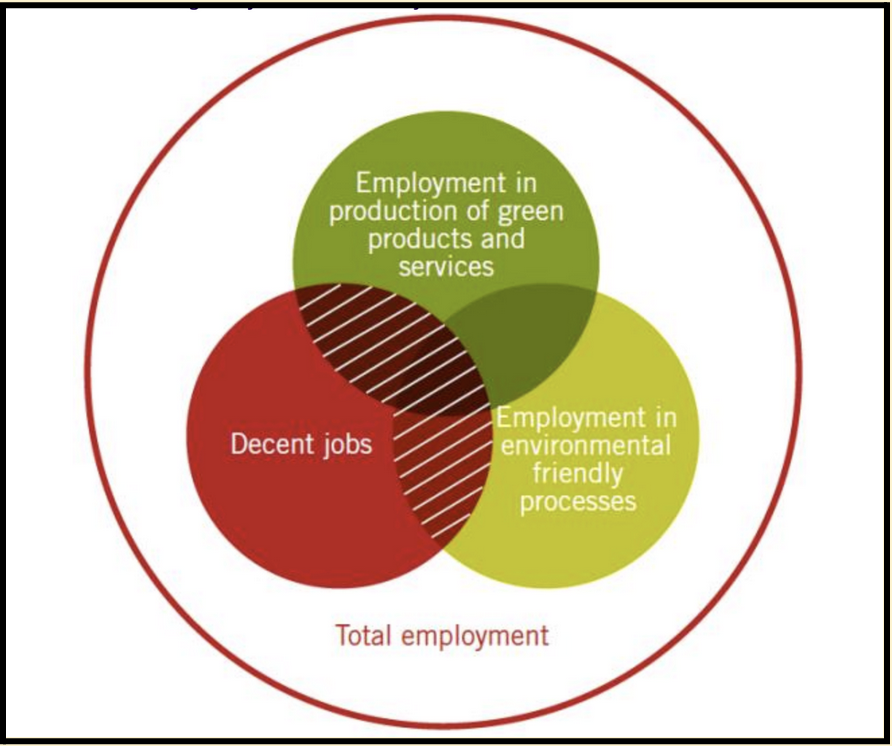Green jobs and the problem of gender disparity
Relevance: GS Paper I & III
Why in News?
The transition to low-carbon development in India has the potential to create around 35 million green jobs by 2047, many of which will be in sectors such as manufacturing, construction, renewable energy, energy efficiency, and automobiles.
|
Beyond Editorial: What is a green job?
|
Gender disparity in green jobs:
- Women are often underrepresented in the green sectors, with men transitioning to green jobs faster than women.
- Despite India increasing its renewable energy capacity by 250% between 2015 and 2021, women comprised only 11% of workers in the solar rooftop sector.
- The Annual Survey of Industries 2019-20 shows that women workers are mostly concentrated in the apparel, textile, leather, food, and tobacco industries.
- In contrast, a 2019 report by the Confederation of Indian Industry (CII) shows that men comprise 85% of the workforce in infrastructure, transport, construction, and manufacturing sectors.
- A 2023 study by the Skill Council for Green Jobs indicated that 85% of the training for green skills was imparted to men, while over 90% of women believed that social norms limited their participation in training for green jobs.
- In India, despite 42.7% of the total number of STEM graduates being women, they represent only 30.8% in engineering, manufacturing and construction programmes, which are the key sectors for green transition.
Significance of including women in green jobs:
- Empowering women and advancing gender equity in climate actions is crucial for unlocking the co-benefits of a low-carbon and environmentally sustainable economy.
- In the short run, it can address the gender biases in the Indian labour market and improve women’s labour force participation rates.
- This can improve women’s agency and empowerment in the long run by creating economic, technical, and social opportunities.
Challenges regarding women’s inclusion:
- Restrictive social norms, such as the belief that women are unsuitable for certain technical roles, safety concerns, lower representation in STEM subjects, and familial constraints, limit women's participation in training for green jobs.
- There is limited data to understand the landscape of women’s work for green jobs in India.
- Globally, women are being left behind in the global race to achieve climate targets and sustainability goals.
- This is particularly evident in transitioning to a low-carbon economy, where new opportunities are created alongside job displacement and transformation.
Way forward:
- Conducting gender analysis: It is essential to build evidence on low-carbon transitions' present and future impact on women workers and entrepreneurs while considering women's hidden and invisible roles across different sectors and geographies.
- This could be done by conducting gender analysis, collecting gender statistics on green jobs through periodic labour force surveys and mobilising additional resources to emphasise and encourage women’s role in the green transition.
- Mapping emerging areas for green growth and collecting sex-disaggregated data on green jobs could be the starting point to improve women’s participation.
- Mitigating gender bias and stereotyping: There is a strong need to review the status quo, map women's current roles, address structural barriers that hinder women’s employment choices and create a conducive ecosystem to foster their participation in green jobs.
- Businesses must recognize the centrality of gender justice and ensure equity throughout the process of the green transition by mitigating barriers that exist due to stereotyping or gender bias and fostering equitable job opportunities for a just transition that benefits everyone.
- Gender-focused financial policies: Collateral-free lending, financial literacy training, and building supportive networks are crucial steps to unlocking their potential.
- Suitable tools must be developed to assess creditworthiness, disburse loans, and reduce operational costs for women-owned businesses.
- Promoting women's leadership: Increasing the number of women in leadership positions to incorporate gender-specific needs in low-carbon development strategies can promote women’s integration into green jobs.
- Multi-pronged strategy for gender-just transition: An approach that focuses on employment, social protection, reducing the burden of care work, and enabling skill development is needed.
- Partnerships and collaboration: Partnerships across government, private sector, and other stakeholders are necessary to leverage the benefits of innovation, technology, and finance for women entrepreneurs and workers.
- The recently launched ‘Gender-Responsive Just Transitions and Climate Action Partnership, ' which focuses on improved data, targeted finance, and skill development during COP 28’s high-level dialogue, is a critical stride towards justice and inclusivity in transition planning.
- Capacity building: Given the unequal landscape of women’s work and participation in green jobs, it is necessary to ensure that women can access emerging opportunities from low-carbon transitions.
- Early hands-on learning, mentorship, scholarships, financial assistance, and awareness generation are crucial.
Conclusion:
Green jobs have the potential to address gender inequality significantly. However, women currently face several challenges in transitioning to these types of jobs. It's crucial to build capacity and support women to help them meet the demands of this new world of work. By doing this, we can co-design a future pathway that is socially equitable and inclusive for everyone.



